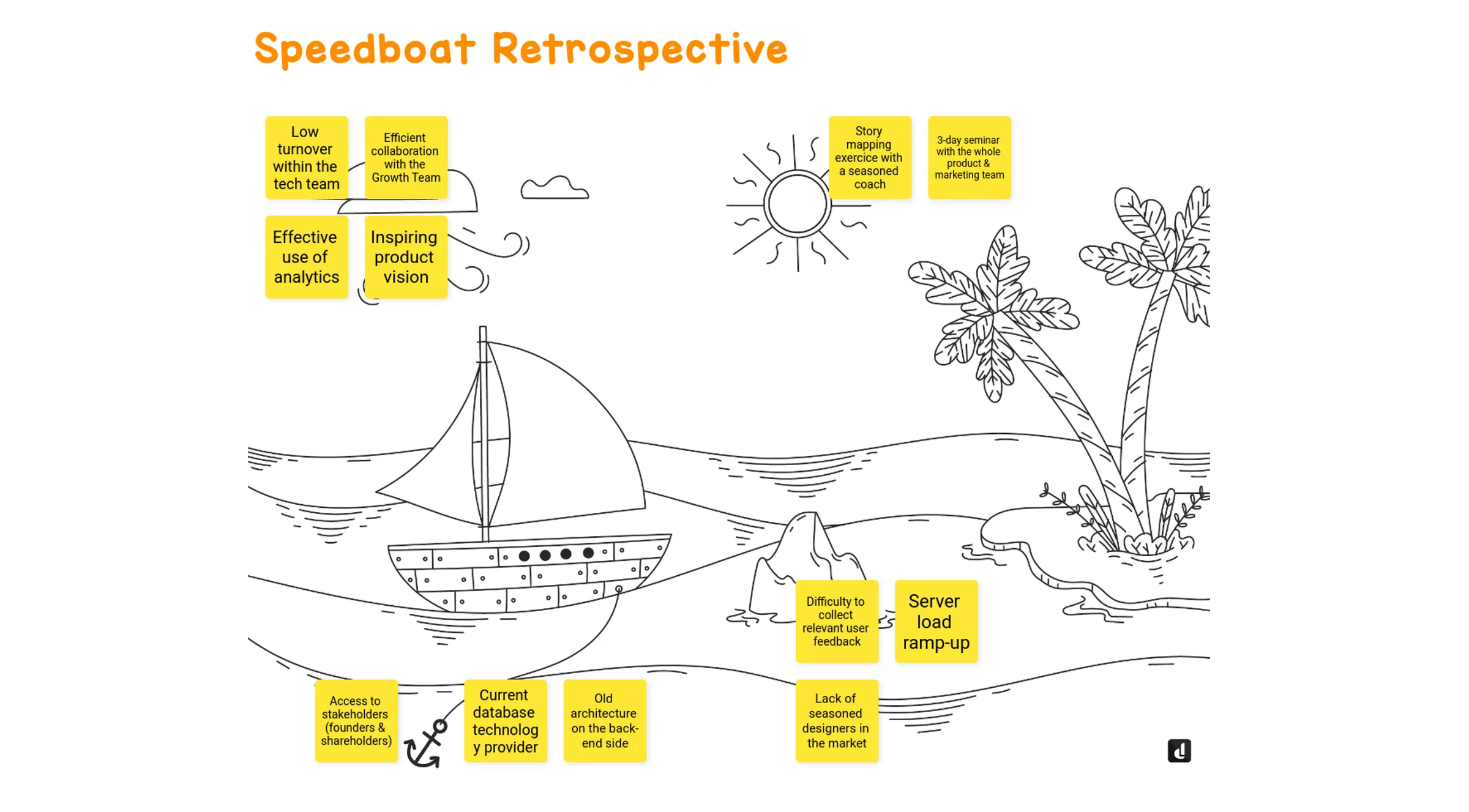Speedboat Retrospective

What is the Speedboat Retrospective?
The Speedboat Retrospective is a classic retrospective format that focuses on identifying the strengths and weaknesses of a project or team, as well as any obstacles that may arise in the future. It is a compelling retrospective theme particularly appreciated by Agile teams that you can carry out at the end of a sprint.
The template is a large illustration representing a sailing boat sailing on the sea towards an island. Each element of this illustration has its own meaning:
- The boat embodies the team and/or the project;
- The island symbolizes the objective to be achieved;
- The wind represents the elements that move the team or the project forward, its strengths;
- The anchor materializes the elements that slow down the team or the project, its weaknesses or its problems;
- The sun illustrates the positive points of the sprint or the period that has just passed, for example, elements that could potentially be relevant to resume during the next sprint;
- The rocks symbolize the identified obstacles or risks that could jeopardize the achievement of the objective.
How to animate the Speedboat Retrospective?
The Speedboat Retrospective generally takes place in 5 stages:
-
Step 1: Presentation of the workshop
First, the facilitator or the Scrum Master explains to the participants the meaning of each canvas element: the boat, the island, the wind, the anchor, the sun, and the rocks.
-
Step 2: Individual reflection
During a defined period of 5 to 10 minutes, participants are invited to note their ideas related to each category described in Step 1 on stickies.
Reflection must be individual; as such, you can use the polling booth mode to prevent participants from influencing each other.
-
Step 3: Commenting and reorganizing ideas
During step 3, each participant comments on the ideas they previously noted on their stickies. The other participants can ask questions to ensure that the points presented are understood.
As a facilitator or Scrum Master, you can group similar ideas within the same theme or help participants reformulate their words to prevent any ambiguity of interpretation later.
-
Step 4: Proposal of areas for improvement
During a new period of 5 to 10 minutes, participants are invited to suggest improvement areas and place the stickies with ideas on the island.
-
Step 5: Selection of the most relevant areas for improvement
For example, using a voting session, the facilitator or the Scrum Master collects the opinions of the participants as to the proposal they consider the most relevant. Depending on the number of participants, you can keep between 3 and 5 areas of improvement, no more.
Each area of improvement must be assigned to a manager responsible for monitoring actions.
Some advice and tips from an Agile Coach
Naya Luceau, a freelance Agile Coach & Scrum Master, has a long experience running retrospectives. Here, she shares some valuable tips to help you make this essential ceremony a success:
- Speedboat is the format that many Agile teams start with. It is easily understandable and transposable to the life of a team, whether we are talking about a sprint or a particular event;
- Help participants project themselves by storytelling: “We are all in the same boat, and we are moving together towards the island on the horizon. What is it about ?”
- As for this format or others, I would advise recalling the interpretation of the different symbols of the canvas (here on pink stickies). Indeed, this can help the team during its reflection. You can also prefill the canvas with one example per symbol.
Some suggested resources to learn more about the Speedboat Retrospective
- A detailed article by training platform Tech Agilist: Sailboat or Speedboat – Sprint Retrospective.
- A detailed video by OeLean YouTube channel: Agile Retrospectives: Speed Boat Retrospective.